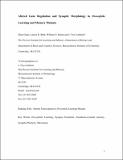Altered gene regulation and synaptic morphology in Drosophila learning and memory mutants
Author(s)
Guan, Zhuo; Buhl, Lauren Kaye; Quinn, William G.; Littleton, J. Troy
DownloadGuan Littleton et al[1].pdf (2.410Mb)
OPEN_ACCESS_POLICY
Open Access Policy
Creative Commons Attribution-Noncommercial-Share Alike
Terms of use
Metadata
Show full item recordAbstract
Genetic studies in Drosophila have revealed two separable long-term memory pathways defined as anesthesia-resistant memory (ARM) and long-lasting long-term memory (LLTM). ARM is disrupted in radish (rsh) mutants, whereas LLTM requires CREB-dependent protein synthesis. Although the downstream effectors of ARM and LLTM are distinct, pathways leading to these forms of memory may share the cAMP cascade critical for associative learning. Dunce, which encodes a cAMP-specific phosphodiesterase, and rutabaga, which encodes an adenylyl cyclase, both disrupt short-term memory. Amnesiac encodes a pituitary adenylyl cyclase-activating peptide homolog and is required for middle-term memory. Here, we demonstrate that the Radish protein localizes to the cytoplasm and nucleus and is a PKA phosphorylation target in vitro. To characterize how these plasticity pathways may manifest at the synaptic level, we assayed synaptic connectivity and performed an expression analysis to detect altered transcriptional networks in rutabaga, dunce, amnesiac, and radish mutants. All four mutants disrupt specific aspects of synaptic connectivity at larval neuromuscular junctions (NMJs). Genome-wide DNA microarray analysis revealed ∼375 transcripts that are altered in these mutants, suggesting defects in multiple neuronal signaling pathways. In particular, the transcriptional target Lapsyn, which encodes a leucine-rich repeat cell adhesion protein, localizes to synapses and regulates synaptic growth. This analysis provides insights into the Radish-dependent ARM pathway and novel transcriptional targets that may contribute to memory processing in Drosophila.
Date issued
2011-03Department
Massachusetts Institute of Technology. Department of Biology; Massachusetts Institute of Technology. Department of Brain and Cognitive Sciences; Picower Institute for Learning and MemoryJournal
Learning & Memory
Publisher
Cold Spring Harbor Laboratory Press
Citation
Guan, Z., L. K. Buhl, W. G. Quinn, and J. T. Littleton. “Altered Gene Regulation and Synaptic Morphology in Drosophila Learning and Memory Mutants.” Learning & Memory 18, no. 4 (March 21, 2011): 191–206.
Version: Author's final manuscript
ISSN
1072-0502
1549-5485